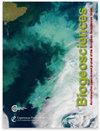Reconstructing the ocean's mesopelagic zone carbon budget: sensitivity and estimation of parameters associated with prokaryotic remineralization
IF 3.9
2区 地球科学
Q1 ECOLOGY
引用次数: 0
Abstract
Abstract. Through the constant rain of sinking marine particles in the ocean, carbon (C) trapped within is exported into the water column and sequestered when reaching depths below the mesopelagic zone. Atmospheric CO2 levels are thereby strongly related to the magnitude of carbon export fluxes in the mesopelagic zone. Sinking particles represent the main source of carbon and energy for mesopelagic organisms, attenuating the C export flux along the water column. Attempts to quantify the amount of C exported versus C consumed by heterotrophic organisms have increased in recent decades. Yet, most of the conducted estimations have led to estimated C demands several times higher than the measured C export fluxes. The choice of parameters such as growth efficiencies or various conversion factors is known to greatly impact the resulting C budget. In parallel, field or experimental data are sorely lacking to obtain accurate values of these crucial overlooked parameters. In this study, we identify the most influential of these parameters and perform inversion of a mechanistic model. Further, we determine the optimal parameter values as the ones that best explain the observed prokaryotic respiration, prokaryotic production and zooplankton respiration. The consistency of the resulting C budget suggests that such budgets can be adequately balanced when using appropriate parameters.重建海洋中上层碳收支:原核再矿化相关参数的敏感性和估计
摘要通过海洋中不断下沉的海洋颗粒,被困在其中的碳(C)被输出到水柱中,并在到达中远洋带以下的深度时被隔离。因此,大气CO2水平与中上层区碳输出通量的大小密切相关。下沉颗粒是中浮游生物碳和能量的主要来源,减弱了沿水柱的碳输出通量。近几十年来,对C出口量与异养生物消耗的C量进行量化的尝试有所增加。然而,大多数进行的估算导致估算的碳需求数倍于测量的碳出口通量。众所周知,诸如增长效率或各种转换因子等参数的选择会极大地影响最终的C预算。同时,现场或实验数据严重缺乏,无法获得这些被忽视的关键参数的准确值。在这项研究中,我们确定了这些参数中最具影响力的,并进行了一个机制模型的反演。进一步,我们确定了最优参数值,以最好地解释观察到的原核呼吸,原核生产和浮游动物呼吸。由此产生的C预算的一致性表明,当使用适当的参数时,这些预算可以得到充分的平衡。
本文章由计算机程序翻译,如有差异,请以英文原文为准。
求助全文
约1分钟内获得全文
求助全文
来源期刊

Biogeosciences
环境科学-地球科学综合
CiteScore
8.60
自引率
8.20%
发文量
258
审稿时长
4.2 months
期刊介绍:
Biogeosciences (BG) is an international scientific journal dedicated to the publication and discussion of research articles, short communications and review papers on all aspects of the interactions between the biological, chemical and physical processes in terrestrial or extraterrestrial life with the geosphere, hydrosphere and atmosphere. The objective of the journal is to cut across the boundaries of established sciences and achieve an interdisciplinary view of these interactions. Experimental, conceptual and modelling approaches are welcome.
 求助内容:
求助内容: 应助结果提醒方式:
应助结果提醒方式:


